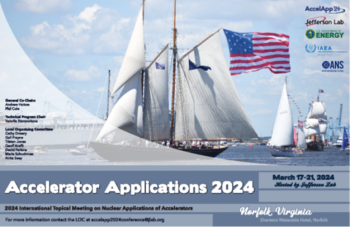Sheraton Norfolk Waterside
777 Waterside Dr.
Norfolk, VA 23510
The 2024 International Topical Meeting on Nuclear Applications of Accelerators conference will follow the usual format of plenary and parallel sessions.
The call for abstracts will open July 10, 2023 and will close on December 2, 2023. Exceptional contributions may be promoted to a plenary talk by the Program Committee. All accepted talks and posters will be allocated space in the published proceedings of 2024 International Topical Meeting on Nuclear Applications of Accelerators. The proceedings will be published in an open access journal after papers have been peer-reviewed under the supervision of the Program Committee.
Submissions
Abstract acceptance notifications should occur after December 4, 2023.
- Parallel talks are allotted a total time of 15 minutes, including questions.
- Plenary talks are allotted a total time of 30 minutes, including questions.
- Oral presentation slides should be prepared in 16:9 widescreen format.
- Posters are requested to be in A0 portrait format (841 mm W x 1189 mm H). Posters will be on display the day before and of their poster session. Posters will be recycled if not picked up prior to after their session. Tuesday Poster Session should be prepared to bring their poster on Monday and find their assigned positions. Thursday Poster Session may begin to set up their posters on Wednesday morning.
- Sample Poster Download (PPTX)
- Oral Presentation Template (PPTX)
All accepted talks and posters will be allocated space in the peer-reviewed proceedings of the 2024 International Topical Meeting on Nuclear Applications of Accelerators. The paper submission and review will be scheduled after the conference. Please refer to the conference Indico site for detailed speaker instructions (add link.)
Abstract guidelines (Abstract Submission opens July 10, 2023)
Selection of talks and posters will be made on the basis of submitted abstracts. Parallel talks and posters will be organized in tracks, as indicated in the table below. The Program Committee will decide which contributions will become oral presentations, and which become posters. Exceptional contributions may be proposed for promotion to a plenary talk by the Program Committee.
- The recommended length of your abstract is 150-250 words, but there is no hard limit.
- Submitters of abstracts are required to select an appropriate track; optionally a second choice of track can be indicated; an abstract will be assigned by the reviewers to only one track.
- Consider carefully the track to which you wish to submit your paper - submitting to the wrong track will slow down the process.
- If you would like your abstract to be considered for promotion to a plenary talk, please indicate that.
- If you have difficulty selecting a track from the list, please send an email to (insert contact email) explaining the problem.
Submitters are also asked to make sure that their email addresses and those of the proposed presenters are their primary email addresses.
2024 International Topical Meeting on Nuclear Applications of Accelerators
| List of Tracks | Associated Keywords |
|---|---|
|
Track 1: |
Progress at currently operating facilities and facilities under construction; Future, upgrades, and reset possibilities; Shutdown plans and decommissioning plans; Management and strategy for accelerator facilities; Accelerator Driven Systems |
|
Track 2: |
New concepts and prototyping for accelerator design (including low energy); Needs for codes and model development; new trends in instrumentation; Radiation protection and shielding; Availability and reliability analyses |
| Track 3: High-power Accelerator Components and Targets |
Windows, beam monitoring systems, and beam dumps; Targets |
| Track 4: Nuclear Data |
Nuclear reaction models and applications; Charges particle, fission and fusion cross-sections and application; Photonuclear cross-sections and applications; High energy particle modeling, experiments, and applications |
| Track 5: Accelerators for Material Science |
New structural materials for fission and fusion reactors; Effects of heavy ions on materials; Effects on materials for microelectronics with fast particles; Low energy methods for space, aviation, and other applications |
| Track 6: Accelerators for Security and Forensics |
Border security; Replacing high activity sources with accelerator-based irradiators; Nuclear techniques for forensics |
|
Track 7: |
Environmental monitoring; Climate change and natural disasters |
| Track 8: Medical Applications of Accelerators |
Production of medical radioisotopes; Hadron therapy; BNCT; Radiobiology |
|
Track 9: |
Electron and x-ray irradiation; Industrial applications of ion beams |
|
Track 10: |
Authentication, dating, and characterization; Conservation |
|
Track 11: |
Accelerator technology; Gamma Ray production; General applications |



